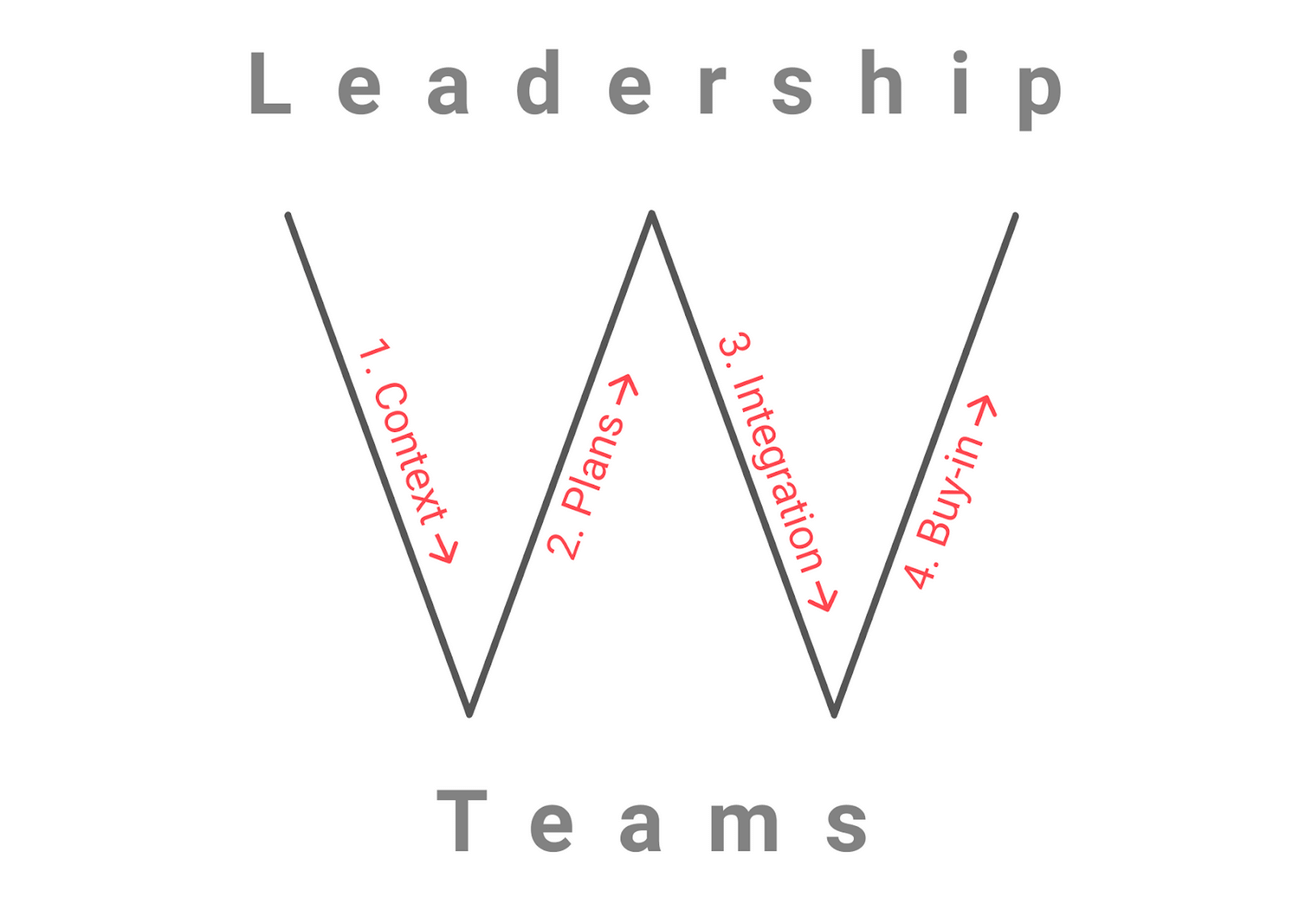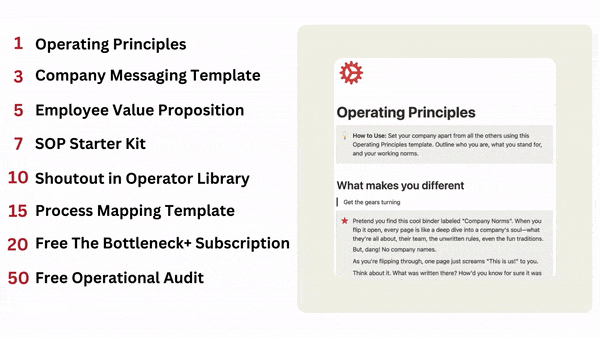
Together With
Read Time: 5.8 Minutes
Good Morning Operators ⚙️
We've reached the end of Q4, which means annual (and quarterly) planning is here. If you’re like most people, this sentence just filled you with dread.
How you handle your planning will drive the rest of the year.
Are you unsure how to conduct an awesome planning session? I got you.
Let’s dive into 3 topics today to make sure you have a great one:
The W Framework
Building Company Strategy Docs
Vanity Metrics
Time to jump in…

Together With Carry
Paying Less in Taxes is the Goal

Giphy
Peter Thiel didn’t pay taxes on $5 billion dollars.
How?
He used a Roth IRA account.
Carry can set you up to help you save on taxes.
They can set up your 401Ks, IRA, and brokerage accounts. All under one roof.
Click below to get started on setting up your mega backdoor Roth IRA.

1. The W Framework
Insight from First Round Review
The root cause of all bad planning is a basic lack of understanding of roles.
Examples include:
What exactly does each stakeholder need to deliver, and to whom?
Who sets the timelines?
Who holds everyone accountable?
So how do you get all teams on the same page?
You’ll need to identify the two groups involved in planning: the Leadership group and the individual Teams.
The Leadership group is generally the company's executive staff (the CEO and direct reports) or the senior leaders of a business unit (VP of Product, VP of Engineering, President of the business unit, etc.).
The Teams are the people executing the actual work. This is your Marketing team, each of the product teams, and the customer service team, etc.
This is the easy part.
The rest of planning is hard.
Planning requires groups to think about different scenarios, align on one future, and then plot a course to get there.
Try using the "W Framework" to ensure everyone moves toward the same future.

Context - Leadership shares a high-level strategy with Teams
Plans - Teams respond with proposed plans
Integration - Leadership integrates into a single plan, and shares it with Teams
Buy-in - Teams make final tweaks, confirm buy-in, and get rolling
Using this high-level framework gives you a rough schedule to follow as you dig into your 2024 plans.
2. Building a Company Strategy Doc
Insight from McKinsey
Good planning requires top-down guidance.
The leadership team has the full view of the company. Siloed Teams only know a portion of the work being completed.
The team needs to know what major investments are happening across the company.
As planning begins, the context of Leadership decisions needs to be told. You must avoid situations where the team interprets these decisions as a mandate.
How should Leadership share that context with teams?
One of the best ways to do this is to assemble and share their first draft of the Company Strategy.
Here are the contents of your company strategy document.
Mission - What are you meant to achieve
Vision - What does it look like once you’ve achieved it
Goal - How do you concretely know you’ve achieved it
Strategy - What is the path to achieving it
Strategic pillars - Three to five key bets that the company needs to make
If you want a template, feel free to reply to this email and I can send one over!
3. Vanity Metrics Will Screw You Over
Insight from First Round Review
Avoid vanity metrics that investors track.
The metrics you should focus on are how to create more value for your business.
A great framework is to ask if the metric shows how valuable your company is right now OR how you can create more value.
If you create more value when you achieve a metric, this is an operational metric worth following. An example is:
The number of minutes a day your product actually gets used
How long for the user to get the service promised
How many times does a customer reach out to support
How do you find your clarity metric?
I recommend combing through your business model. You need to spend time understanding the customer's earliest contact points with your service.
After mapping out their earliest touches, you need to figure out where they spend most of their time once they have the product.
At Firstbase.io, my last startup, we incorporated over 30,000 startups in the US. We found that our customer satisfaction fell a ton if we delayed sending incorporation documents by even 1 day.
Once we shifted our clarity metrics to documents in customers' hands, we saw a massive improvement in word of mouth.
What is your clarity metric?
Go ahead and respond here with your clarity metrics. I can let you know if you are on the right track!
4. What to Measure for Team Culture
Insight from Lattice
Building a great culture is hard. Measuring your culture is even tougher.
Benefits of measuring your culture include:
Retaining and attracting the best talent. Better talent = less of a headache for you
Strengthening employee engagement which helps your bottom line
Fostering innovation and creativity to continue to grow the business
You will need a range of qualitative and quantitative metrics to measure culture. The best cultures have a highly engaged workforce, low turnover rates, and high eNPS.
To get these types of metrics, you’ll need to run pulse surveys, performance reviews, and compensation research.

Tool of the Week*
With the launch of this newsletter and agency, I’m always bandwidth-constrained. I’m sure with all you have going on, you do too.
While looking for an assistant, I stumbled upon Xembly.
Xembly is the AI executive assistant that can save you 8 hours every week.
Need to schedule a meeting with 7+ people?
Need to take meeting notes while staying engaged?
Need to make time to get your action items done?
Xembly’s AI-powered executive assistant, Xena, schedules meetings, takes meeting notes, and helps manage your deadlines.


Operators Library
P.S. To get featured in this section, share the newsletter 10 times (your referral link is below). If you do get 10 referrals, I'll include you in a future issue.

How I Can Help
In case you're new: Who's The Bottleneck?
We’re on a mission to help you build, manage, and scale your startup.
We share high-quality, vetted, and actionable operational content as we learn it from the top 1% of operators.
How we can help you scale:
⚖ Are you tired of wasting time on admin back office work? I have a growth assistant on standby just for you. Click here to lock in your new best friend.
👀 Get your product in front of startup operators by sponsoring this newsletter.
🤝 Grab time with me for a 1:1 session


Support
Small ask: If you enjoyed today’s post, I’d be incredibly grateful if you helped others discover The Bottleneck. Please hit me with a fav or repost on my tweet below.

Spread The Word
Share The Bottleneck with friends to get a few freebies. Maybe you’ll make some new ones on the way 😆
We’ll give you free stuff and more friends if you share a link. Only one link.

{{rp_personalized_text}}


